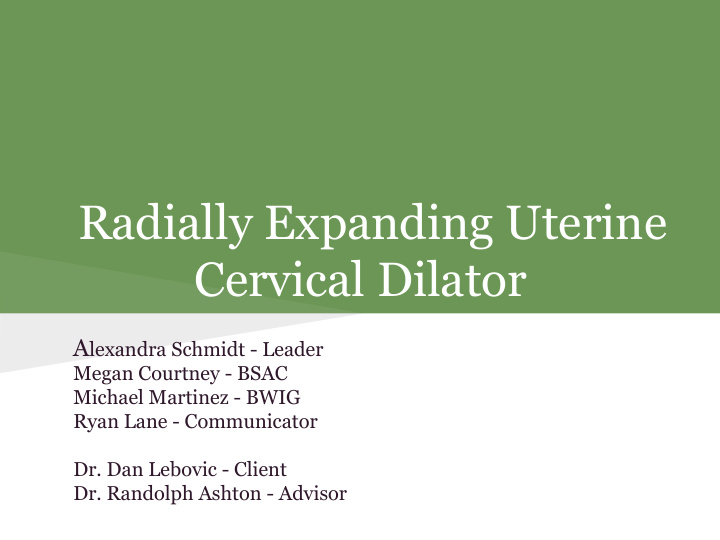



Radially Expanding Uterine Cervical Dilator A lexandra Schmidt - Leader Megan Courtney - BSAC Michael Martinez - BWIG Ryan Lane - Communicator Dr. Dan Lebovic - Client Dr. Randolph Ashton - Advisor
Outline o Problem Statement o Background Information o Design Specifications o Designs and Matrix o Future Work
Problem Statement The current procedure for dilating the cervix requires a doctor to use progressively thicker dilators until the desired diameter is reached. This method is very tedious for the surgeon and may put patients at a higher risk for a uterine perforation. To decrease the risk of a uterine perforation, we are going to make a device that, once inserted through the cervical canal, can be controlled by a surgeon to radially dilate the cervix to a desired diameter as indicated on a dial.
Background Information o Anatomy of uterus o Average length of uterus § 7 cm o Average length of cervical canal § 3.5 cm o Average length of vaginal canal § 15 cm o Procedures o Cleaning uterus o Sample of tissue o Termination of pregnancy o Miscarriage
Existing Products Hegar Dilators Pratt Dilators Problems o Can be very difficult to insert into cervical canal o Higher risk of perforating uterus o Tedious and time consuming
Product Design Specifications o Minimum size: 3 mm in diameter o Maximum size: 1 cm in diameter o Expansion while in cervical canal o Radial expansion o Expansion in increments of 1 mm in diameter o Dial to control expansion and indicate diameter dilated o Indicator to let doctor know when dilator is completely inserted into cervical canal o Total length for ideal prototype: ~30 cm
Design 1 o Uses balloon o Hydraulic pump inputs fluid to balloon o Indicator of total dilation available in separate apparatus Problems o Inconstant pressure throughout balloon o Not favored by client
Design 2 o Uses balloon o Syringe-like input of fluid to balloon o Plunger rod features total cervical diameter Problems o Inconstant pressure throughout balloon o Lack of force using syringe
Design 3 o Coil-like design o Uses dial to control dilation o Has stopper-like feature as indicator of total entry to cervix o Easy to use Problems o Materials o Dial mechanism
Design 4 o Cone shape o "Twisted" into cervix, not pushed directly up o Uses dial o Opens into 4 panels once dilation is complete Problem o Cervical canal dilated unevenly
Design Matrix Criteria ¡ Weight ¡ Design ¡1 ¡ Design ¡2 ¡ Design ¡3 ¡ Design ¡4 ¡ Cost ¡ 10/100 ¡ 4 ¡ 2 ¡ 9 ¡ 9 ¡ Ease ¡of ¡Use ¡ 20/100 ¡ 11 ¡ 8 ¡ 18 ¡ 17 ¡ Feasibility ¡ 20/100 ¡ 12 ¡ 7 ¡ 17 ¡ 17 ¡ Safety ¡ 25/100 ¡ 16 ¡ 13 ¡ 24 ¡ 22 ¡ Durability ¡ 25/100 ¡ 14 ¡ 15 ¡ 23 ¡ 23 ¡ Total ¡ 100 ¡ 57 ¡ 45 ¡ 91 ¡ 88 ¡ Higher numbers — more favorable
Future Work o Continue researching materials o Create more specific schematics of Design 3 o SolidWorks o Prototype o Testing and evaluation
Acknowledgements o Dr. Randolph Ashton o Dr. Dan Lebovic References Images http://monarchmedicalproducts.com/products_2012/category.php?catid=59 http://www.medline.com/product/Pratt-Uterine-Dilators/Uterine-Dilators/ Z05-PF17241 http://www.nuff.org/health_theuterus.htmi9 http://www.cookmedical.com/wh/datasheet.do?id=6078
Recommend
More recommend